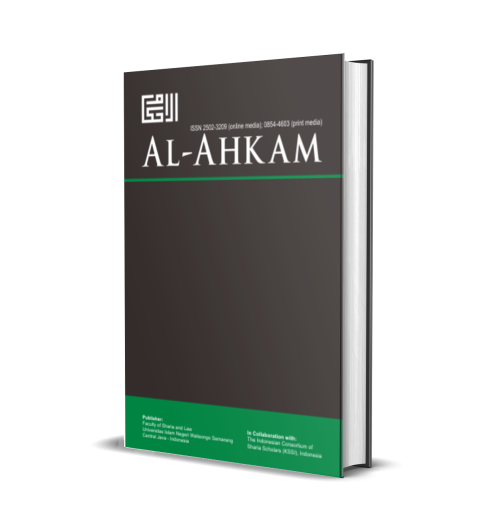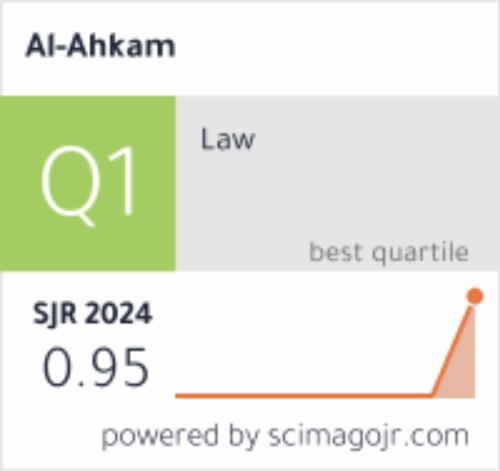Ithbāt Ṭalāq: An Offer of Legal Solutions to Illegal Divorce in Indonesia
DOI:
https://doi.org/10.21580/ahkam.2022.32.2.11720Keywords:
illegal divorce, ithbāt ṭalāq, ta’zīrAbstract
The dispute between Islamic law and positive law is continuously ongoing regarding the practice of illegal divorce. This practice is valid in Islamic law as long as the conditions and pillars are fulfilled. However, in Islamic law, it is considered a violation of marriage norms. The urgency of this study lies in the discourse of ithbāt ṭalāq to bridge the rise of illegal divorce in society. Through a literature review with a juridical approach to finding a legal basis for a case in concreto, this article shows that ithbāt ṭalāq functions as an instrument that can solve disputes between Islamic law and positive law. Through this instrument, husbands who force divorce out of court can be considered criminal actors who must be given sanctions in the form of ta'zīr (fine).
Downloads
References
Abubakar, Fatum. ‘Islamic Family Law Reform: Early Marriage and Criminalization (A Comparative Study of Legal Law in Indonesia and Pakistan)’. Al-Ahkam Jurnal Ilmu Syari’ah dan Hukum 4, no. 2 (2019): 97–118. https://doi.org/10.22515/alahkam.v4i2.1667.
Antons, Christoph, and Daniel S. Lev. ‘Colonial Law and the Genesis of the Indonesian State’. In Law and Society in East Asia, 3–20. Routledge, 2018. https://doi.org/10.4324/9781315091976-1.
Bakri, Nurdin Bakri Nurdin, and Antoni Antoni. ‘Talak di Luar Pengadilan menurut Fatwa MPU Aceh No 2 Tahun 2015 tentang Talak’. Samarah: Jurnal Hukum Keluarga dan Hukum Islam 1, no. 1 (2017): 52–71. https://doi.org/10.22373/sjhk.v1i1.1570.
Bakry, Kasman, and Edi Gunawan. ‘The Implementation of Islamic Law at the Early Spread of Islam in Indonesian Archipelago’. Jurnal Ilmiah Al-Syir’ah 16, no. 2 (2018): 113–25. https://doi.org/10.30984/jis.v16i2.685.
Direktori Putusan Mahkamah Agung Republik Indonesia. ‘Rumusan Kamar’. Direktori Putusan Mahkamah Agung Republik Indonesia, 2019. https://putusan3.mahkamahagung.go.id/rumusan_kamar/.
Fikri, Fikri, Saidah Saidah, Aris Aris, and Wahidin Wahidin. ‘Contextualization of Divorce Through Fiqh and National Law in Indonesia’. Al-Ulum 19, no. 1 (2019): 151–70. https://doi.org/10.30603/au.v19i1.643.
Hakim, Hasan Nur. ‘Penindakan terhadap Pelaku Penjatuhan Talak di Luar Pengadilan melalui Sarana/Pendekatan Pidana (Penal Approachment) ’. Al-Fikra: Jurnal Ilmiah Keislaman 15, no. 2 (2016): 326–40. https://doi.org/10.24014/af.v15i2.4020.
Hidayat, Ilham, Mardenis, and Yaswirman. ‘Problems Arising from Talak Divorce Outside the Court’. International Journal of Multicultural and Multireligious Understanding 6, no. 4 (2019). https://doi.org/10.18415/ijmmu.v6i10.919.
Husaeni, Muh. Irfan. ‘Pemohon Mendalilkan Telah Talak Tiga di Luar Pengadilan, Bagaimana Sikap Hakim?’ Direktorat Jenderal Badan Peradilan Agama, 5 March 2014. https://badilag.mahkamahagung.go.id/artikel/20147-pemohon-mendalilkan-telah-talak-tiga-di-luar-pengadilan-bagaimana-sikap-hakim-oleh-muh-irfan-husaeni-sag-msi.html.
Irianto, Sulistyowati. Perempuan di antara Berbagai Pilihan Hukum (Studi Mengenai Strategi Perempuan Batak untuk Mendapatkan Akses kepada Harta Waris melalui Proses Peyelesaian Sengketa). Jakarta: Yayasan Obor Indonesia, 2012.
Ismail, Faisal. ‘Religion, State, and Ideology in Indonesia: A Historical Account of the Acceptance of Pancasila as the Basis of Indonesian State’. Indonesian Journal of Interdisciplinary Islamic Studies (IJIIS) 1, no. 2 (2018): 19–58. https://doi.org/10.20885/ijiis.vol1.iss2.art2.
Katz, Elizabeth D. ‘Criminal Law in a Civil Guise: The Evolution of Family Courts and Support Laws’. The University of Chicago Law Review 86, no. 5 (2019): 1241–1309. http://perma.cc/34A6-M2AC.
Kusnandar, Viva Budy. ‘Inilah 10 Provinsi Dengan Penduduk Berstatus Cerai Hidup Terbanyak’. Databoks, 7 September 2021. https://databoks.katadata.co.id/datapublish/2021/09/07/inilah-10-provinsi-dengan-penduduk-berstatus-cerai-hidup-terbanyak.
Lukito, Ratno. Hukum Sakral dan Hukum Sekuler (Studi tentang Konflik dan Resolusi dalam Sistem Hukum Indonesia). Edited by Muhammad Syukri and Inyiak Ridwan Muzir. Jakarta: Pustaka Alvabet, 2008.
Mahkamah Agung Republik Indonesia. Pedoman Pelaksanaan Tugas dan Administrasi Peradilan Agama. Jakarta: Direktorat Jenderal Badan Peradilan Agama, 2013.
Maimun. ‘The Women’s Rights in Divorce and Discourse of Gender Equality in the Dynamics of Divorce in Madura’. Samarah Jurnal Hukum Keluarga dan Hukum Islam 6, no. 1 (2022): 468–92. https://doi.org/10.22373/sjhk.v6i1.12804.
Manan, Abdul. ‘Penemuan Hukum oleh Hakim dalam Praktek Hukum Acara di Pengadilan Agama’. Jurnal Hukum dan Peradilan 2, no. 2 (2013): 189–202. https://doi.org/10.25216/jhp.2.2.2013.189-202.
Manullang, Sardjana Orba. ‘Understanding the Sociology of Customary Law in the Reformation Era: Complexity and Diversity of Society in Indonesia’. Linguistics and Culture Review 5, no. S3 (2021): 16–26. https://doi.org/10.21744/lingcure.v5ns3.1352.
Mawardi, Imam. ‘Islamic Law and Imperialism: Tracing on the Development of Islamic Law In Indonesia and Malaysia’. Al-Ihkam: Jurnal Hukum & Pranata Sosial 13, no. 1 (2018): 24. https://doi.org/10.19105/al-ihkam.v13i1.1583.
Minarrahmah, Nuzurrizky. ‘Legal Penalty of Divorce Outside the Religious Court in Indonesia, Malaysia, and Brunei Darussalam’. Maulana Malik Ibrahim State Islamic University Malang, 2020. http://etheses.uin-malang.ac.id/17455/6/16210007.pdf.
Moeljatno. Asas-Asas Hukum Pidana. Yogyakarta: Rineka Cipta, 2002.
Mudzhar, M. Atho. ‘The Legal Reasoning and Socio-Legal Impact of the Fatwās of the Council of Indonesian Ulama on Economic Issues’. Ahkam: Jurnal Ilmu Syariah 13, no. 1 (2013): 9–20. https://doi.org/10.15408/ajis.v13i1.946.
Nasir, Mohamad Abdun. ‘Islamic Law and Paradox of Domination and Resistance: Women’s Judicial Divorce in Lombok, Indonesia’. Asian Journal of Social Science 44, no. 1/2 (2016): 78–103. https://www.jstor.org/stable/43953983.
Nasir, Mohamad Abdun. ‘Negotiating Muslim Interfaith Marriage in Indonesia: Integration and Conflict in Islamic Law’. Mazahib Jurnal Pemikiran Hukum Islam 21, no. 2 (2022). https://doi.org/10.21093/mj.v21i2.5436.
Nurhadi, Nurhadi. ‘Perceraian di Bawah Tangan Perspektif Hukum Islam dan Hukum Indonesia’. Al-Mawarid: Jurnal Syari’ah & Hukum 1, no. 2 (2019): 179–201. https://doi.org/10.20885/mawarid.vol1.iss2.art5.
Onions, C. T. The Shorter Oxford English Dictionary. Oxford: Clarendon Press, 1964.
Ridho, Muhamad. ‘Itsbat Nikah terhadap Pelaku Perceraian di Luar Pengadilan dan Implikasi Hukumnya’. Bil Dalil (Jurnal Hukum Keluarga Islam) 1, no. 02 (2016): 81–98. https://doi.org/10.32678/bildalil.v1i02.124.
Rosyid, Maskur. ‘Kriminalisasi terhadap Hukum Keluarga di Dunia Muslim’. Al Amin: Jurnal Kajian Ilmu dan Budaya Islam 3, no. 1 (2020): 175–93. https://doi.org/10.36670/alamin.V3I1.48.
Rudy. ‘The Pathway of Civil Law Development in Indonesia: Laws on Land’. In Civil Law Reforms in Post-Colonial Asia, edited by Yuka Kaneko, 71–82. Kobe: Springer, 2019. https://doi.org/10.1007/978-981-13-6203-3_4.
Sari, Novia, Abdul Wahab Naf’an, Paisal Paisal, and Pirza Adzkia. ‘Opportunities and Challenges of Isbat Talak in Divorce in Indonesia and Abroad’. Al-Qisthu: Jurnal Kajian Ilmu-Ilmu Hukum 19, no. 2 (2021): 106–20. https://doi.org/10.32694/qst.v19i2.1084.
Siregar, Ramadhan Syahmedi. ‘Dampak Perceraian yang tidak Sesuai dengan Prosedur Perundang-Undangan’. Fitrah: Jurnal Kajian Ilmu-Ilmu Keislaman 1, no. 1 (2015): 161–76. https://doi.org/10.24952/fitrah.v1i1.333.
Wardhani, Tyesta Addy Listya, Muhammad Dzikirullah H Noho, and Aga Natalis. ‘The Adoption of Various Legal Systems in Indonesia: An Effort to Initiate the Prismatic Mixed Legal Systems’. Cogent Social Sciences 8, no. 1 (2022). https://doi.org/10.1080/23311886.2022.2104710.
Zainuddin, Zainuddin, Khairina Khairina, and Sulastri Caniago. ‘Itsbat Talak dalam Perspektif Hukum Perkawinan di Indonesia’. Al-Ahwal: Jurnal Hukum Keluarga Islam 12, no. 1 (2019): 29–45. https://doi.org/10.14421/ahwal.2019.12103.
Zawawi, Majdah. ‘Legal Analogy in Islamic Law and Common Law: Masālik Al-‘Illah, Obiter Dicta and Distinguishing Compared’. IIUM Law Journal 10, no. 1 (2002): 41–46. http://irep.iium.edu.my/17144.
Downloads
Published
How to Cite
Issue
Section
License
By submitting an article to the journal, the author(s) agree to transfer the published article's copyright to the journal, which will act as the publisher. This means the journal will have the right to publish the article in various forms, including reprints. The journal will maintain the publishing rights to the published articles.
In line with the license, authors and third parties (readers, researchers, and others) are allowed to share and adapt the material. In addition, the material must be given appropriate credit, provided with a link to the license, and indicated if changes were made. If authors remix, transform or build upon the material, authors must distribute their contributions under the same license as the original.



